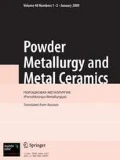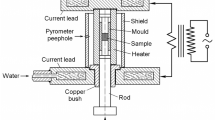Abstract
Pressureless sintering of boron carbide ceramics containing 0-25 vol. % TiB2 phase, produced via an in-situ chemical reaction between B4C, TiO2, and elemental carbon, was studied in the isothermal and constant-heating-rate regimes. The presence of TiB2 results in a decrease in activation energy for sintering from 717 kJ/mol at 0 vol. % TiB2 to 266 kJ/mol at 25 vol. % TiB2. Ceramic bodies of B4C ― TiB2 particulate composites with relative densities of up to 99% were sintered without pressure at temperatures of 2050-2100°C. Grain boundary diffusion is the primary mechanism of TiB2 particle coarsening. TiB2 particle size is bimodal depending on whether the particle is confined within a B4C grain or located on the grain boundary. Densification behavior of the B4C ― TiB2 system is identical at different heating rates in the temperature range of 1800-2150°C.
Similar content being viewed by others
REFERENCES
B. L. Grabchuk and P. S. Kislyi, “Sintering of boron carbide,” Sov. Powder Metall., 8, 11-16 (1974).
T. Vasilos and S. K. Dutta, “Low temperature hot-pressing of boron carbide and its properties,” Amer. Cer. Soc. Bull., 53, 453-454 (1973).
J. W. Henney and J. W. S. Jones, Pat. 2014193, Br., Publ. 1978.
D. Stibbs, G. G. Brown, and R. Thompson, Pat. 3,146,571, U.S., Publ.1973.
S. Prochazka, Pat. 4,005,235, U.S., Publ. 1977.
G. Q. Weaver, “Sintered high-density boron carbide,” Pat. 4,320,204, U.S., Publ. 1982.
M. Bougoin, F. Thevenot, J. Dubois, and G Fantozzi, “Synthese et caractensation de ceramiques denses en carbure de bore,” J. Less Common. Met., 114, 257-271 (1985).
R. Telle and G. S. Petzow, “Mechanisms in the liquid-phase sintering of boron carbide with silicon based melts,” Mater. Sci. Monogr., 38A, 961-973 (1987).
B. Champagne and R. Angers, “Mechanical properties of hot-pressed B -B4C materials,” J. Amer. Ceram. Soc., 62, 49-53 (1979).
V. Skorokhod, M. D. Vlajic, and V. D. Krstic“Mechanical properties of pressureless sintered boron carbide containing TiB2 phase,” J. Mater. Sci. Lett., 15, 1337-1339 (1996).
J. C. Wurst and J. A. Nelson, “Linear intercept technique for measuring grain size in two-phase polycrystalline ceramics,” J. Amer. Ceram. Soc., 55, 109 (1972).
V. V. Skorokhod and A. V. Ragulya, “Features of nanocrystalline structure formation on sintering of ultrafine powders,” Nanostructured Materials Science and Technology [in Russian], Gan-Mong Chow and N. I. Noskova (eds.), Kluwer Academic Publishers, Dordrecht, Boston, London (1998), p. 387-404.
J. Wang and R. Raj, “Estimate of the activation energies for boundary diffusion from rate-controlled sintering of pure alumina, and alumina doped with zirconia or titania,” J. Amer. Ceram. Soc., 73, 1172-1175 (1990).
Author information
Authors and Affiliations
Rights and permissions
About this article
Cite this article
Skorokhod, V.V. Processing, Microstructure, and Mechanical Properties of B4C ― TiB2 Particulate Sintered Composites. Part I. Pressureless Sintering and Microstructure Evolution. Powder Metallurgy and Metal Ceramics 39, 414–423 (2000). https://doi.org/10.1023/A:1026625909365
Issue Date:
DOI: https://doi.org/10.1023/A:1026625909365



